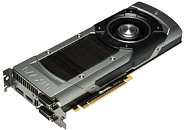- Joined
- Oct 9, 2007
- Messages
- 47,217 (7.55/day)
- Location
- Hyderabad, India
| System Name | RBMK-1000 |
|---|---|
| Processor | AMD Ryzen 7 5700G |
| Motherboard | ASUS ROG Strix B450-E Gaming |
| Cooling | DeepCool Gammax L240 V2 |
| Memory | 2x 8GB G.Skill Sniper X |
| Video Card(s) | Palit GeForce RTX 2080 SUPER GameRock |
| Storage | Western Digital Black NVMe 512GB |
| Display(s) | BenQ 1440p 60 Hz 27-inch |
| Case | Corsair Carbide 100R |
| Audio Device(s) | ASUS SupremeFX S1220A |
| Power Supply | Cooler Master MWE Gold 650W |
| Mouse | ASUS ROG Strix Impact |
| Keyboard | Gamdias Hermes E2 |
| Software | Windows 11 Pro |
NVIDIA's response to AMD Radeon R9 285 isn't major (a new product launch). The company believes it already has the products out there to take on it. The company is likely working with add-in card partners, and retailers, to tweak pricing of its performance-segment GeForce GTX 770 2GB, bringing its price around the US $275 mark, $25 more than the cheapest R9 285, and roughly the same price as factory-overclocked ones. Its pricing is down from the $325 point it was hovering over.
The GTX 770 costs roughly the same as the GTX 760, for NVIDIA to sell, with the former only imposing slightly higher VRM requirements. Our tests show that the GTX 770 still ends up with better energy efficiency figures than the R9 285. Based on the 28 nm "GK104" silicon, the GTX 770 packs 1,536 CUDA cores, 128 TMUs, 32 ROPs, and a 256-bit wide GDDR5 memory interface.

View at TechPowerUp Main Site
The GTX 770 costs roughly the same as the GTX 760, for NVIDIA to sell, with the former only imposing slightly higher VRM requirements. Our tests show that the GTX 770 still ends up with better energy efficiency figures than the R9 285. Based on the 28 nm "GK104" silicon, the GTX 770 packs 1,536 CUDA cores, 128 TMUs, 32 ROPs, and a 256-bit wide GDDR5 memory interface.

View at TechPowerUp Main Site






